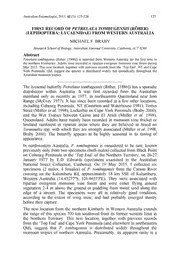
First record of Petrelaea tombugensis (Rober) (Lepidoptera: Lycaenidae) from Western Australia PDF
Preview First record of Petrelaea tombugensis (Rober) (Lepidoptera: Lycaenidae) from Western Australia
Australian Entomologist, 2015, 42 (3): 127-128 127 FIRST RECORD OF PETRELAEA TOMBUGENSIS (ROBER) (LEPIDOPTERA: LYCAENIDAE) FROM WESTERN AUSTRALIA MICHAEL F. BRABY Research School of Biology, Australian National University, Canberra, ACT 0200 Abstract Petrelaea tombugensis (Rober, [1886]) is recorded from Western Australia for the first time in the northern Kimberley. Adults were recorded in riparian evergreen monsoon vine forest during May 2015. This new location, together with previous records from the <Top End9, NT and Cape York Peninsula, Qld, suggest the species is distributed widely but sporadically throughout the Australian monsoon tropics. The lycaenid butterfly Petrelaea tombugensis (Rober, [1886]) has a sporadic distribution within Australia. It was first recorded from the Australian mainland only as recently as 1977, in northeastern Queensland near Iron Range (McEvey 1977). It has since been recorded at a few other locations, including Cobourg Peninsula, NT (Common and Waterhouse 1981), Torres Strait (Muller et al. 1998), Lockerbie on Cape York Peninsula (Braby 2000), and the Wet Tropics between Cairns and El Arish (Muller et al. 1998), Queensland. Adults have mainly been recorded in monsoon vine thicket or lowland rainforest in riparian areas where they are believed to breed on Terminalia spp. with which they are strongly associated (Miller et al. 1998, Braby 2000). The butterfly appears to be highly seasonal in its timing of appearance. In northwestern Australia, P. tombugensis is considered to be rare, known previously only from two specimens (both males) collected from Black Point on Cobourg Peninsula in the 8Top End9 of the Northern Territory, on 26-27 January 1977 by E.D. Edwards (specimens examined in the Australian National Insect Collection, Canberra). On 19 May 2015, I collected six specimens (2 males, 4 females) of P. tombugensis from the Carson River crossing on the Kalumburu Rd, approximately 18 km SSE of Kalumburu, Western Australia (14.45277°S, 126.66373°E). They were associated with riparian evergreen monsoon vine forest and were either flying around vegetation 2-4 m above the ground or puddling from moist sand along the edge of a stream. The specimens were all in relatively good condition, according to the extent of wing wear, and had probably emerged shortly before their capture. The new location from the northern Kimberly in Western Australia extends the range of this species 700 km southwest from its former western limit in the Northern Territory. This new location, together with previous records from the 8Top End9 and Cape York Peninsula (and elsewhere in northeastern Qld), suggest that P. tombugensis is distributed widely throughout the monsoon tropics of northern Australia. Presumably, its apparent rarity is a 128 Australian Entomologist, 2015, 42 (3) consequence of its temporal and spatial distribution, being highly seasonal and restricted to patches of riparian monsoon forest. Further work on the life history and larval food plant specialisation is needed to determine the species9 ecological requirements. Acknowledgments I thank G.J. Paras for his pleasant company in the field and E.D. Edwards for access to material in the ANIC. References BRABY, M.F. 2000. Butterflies of Australia. Their identification, biology and distribution. CSIRO Publishing, Collingwood, Melbourne; xx + 976 pp. COMMON, LF.B. and WATERHOUSE, D.F. 1981. Butterflies of Australia. Revised edition. Angus and Robertson, Sydney; xiv + 682 pp. McEVEY, S.F. 1977. Notes from a collecting trip to Cairns and Iron Range including a new record for the Australian mainland. Victorian Entomologist 7: 59-62. MULLER, C.J., OLIVE, J. and LAMBKIN, T.A. 1998. New records for Petrelaea tombugensis (Röber) (Lepidoptera: Lycaenidae) in Queensland. Australian Entomologist 25: 61-63.
